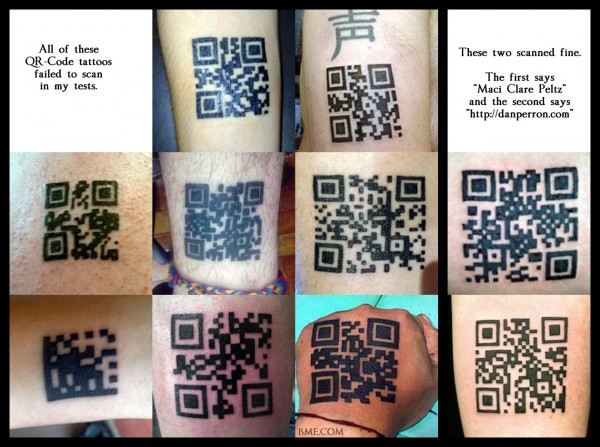I was recently asked if I’d seen the “animated tattoo” that was recently done for the first time, and I replied that I didn’t think this was possible with current technology. The person who asked me the question did a little searching, and discovered that it wasn’t truly an animated tattoo — the tattoo didn’t move — but a tattoo of a QR-code type link that would cause a cellphone to display a specific YouTube video designed to sit as the center piece of the tattoo. This is the very misleadingly labeled news report they got back to me with:
The tattoo was done by French tattooist K.A.R.L. in June of 2011, and claimed to be the “first ever” animated tattoo, but of course readers of ModBlog know that it is neither an animated tattoo, nor is it even the first “augmented reality” tattoo of this type — let alone a particularly impressive one. For example, in May of last year, before K.A.R.L. did this PR stunt, Rob had already covered the subject of augmented reality tattoos here on ModBlog, and over the years many have been posted. A simple search shows that QR-code tattoos like the one K.A.R.L. claims to have invented, are not only incredibly common, but are regularly used in marketing in the form of temporary tattoos.
However — and this is a big “however” — people considering this should be aware that QR-tattoos do not translate well to skin. For starters, most tattoo artists are not particularly adept at the sharp and consistent linework and geometric perfection that QR-Codes demand, and to make matters worse, the undulating contours of the skin are anything but flat, and while QR readers are able to compensate for skew (taking a picture of the code at an angle), they are not able to compensate for warping that comes from the code being on a surface with multiple curves. This limits QR-code tattoos not only to the best artists, but to flat areas of the body. I took a random sample of ten clear pictures of QR-code tattoos, and tried to scan them. I was successful only with two of them. It’s likely that in real life, with careful repositioning and better lighting that I might be able to scan a couple more, but I don’t see more than half of QR-code tattoos being functional, which is pretty depressing — it’s the digital equivalent of a spelling mistake so bad as to make your quote gibberish.
You can zoom that in and see if your phone does any better if you want.
In addition to QR-code tattoos — which are really just an odd way of writing text data that I would argue would be better achieved just using regular letters — there are augmented reality tattoos. These don’t just give your phone a URL. They actually provide a “junction point” for the world of virtual reality to interface with your body. As you may have realized if you read Rob’s article, they provide your phone or computer information about the location, size, and orientation of your body by showing it a symbol that it can recognize from many angles. The computer is then able to take the video shot of your phone and add three-dimensional elements that move synchronized with your body’s movements — thus the term augmented reality. You can find more videos with a simple search for “augmented reality tattoo”, but let me show you a couple relevant videos to get you started. The first one, of the dragon, is from 2009 and one of the first that I know of. The second is more recent, but notable because it uses a realistic skull as its recognition symbol, showing that you don’t have to use a blocky icon that instantly identifies your tattoo as a digital interface.
I know, this falls far short of what people hope for when they hear the words “animated tattoo”, but it’s a start. It shows the dreams that people have for their bodies. It also points out that people are starting to see their bodies as interfaces to the virtual world, which is an important first step for cyberpunk and transhumanist body modification. One day we will surely have animated tattoos in the literal sense, but these QR-code and augmented reality tattoos are an unrelated trend — they are however very interesting for their own merits.
